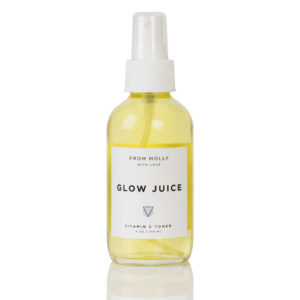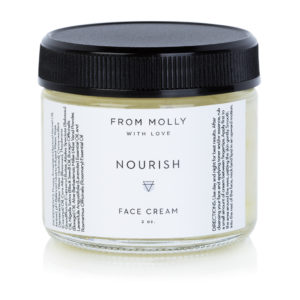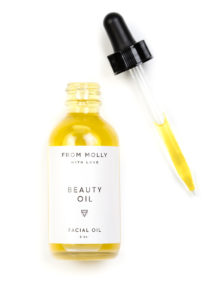
The Five Skin Types
Your skin falls into one of five categories:
- Normal
- Oily
- Dry
- Sensitive
- Combination
Each of these has its own unique characteristics that should be factored in before starting any skin treatment regimen. Let’s learn more about each type:

1. Normal Skin
Normal skin feels elastic (like you could bounce a quarter off of it) and appears vibrant and fresh at all times. Normal skin is the holy grail. That’s because this skin type makes for very few or no breakouts, is not too dry or oily and does not have any marks or blemishes. Normal skin does not feel tight or dry with changes in the weather and these people have very little or no fine lines. The pores are small and sometimes nearly invisible which means that a little foundation goes a long way.
Unfortunately, it is mostly children who have normal skin. Boo.
To sum up, normal skin is characterized by these:
- Fine, even texture
- Smooth surface
- Small pores which are barely visible
- Good balance between oil and moisture
Caring for Normal Skin
Normal skin is the easiest to care for. The best products to use for this skin type are those that support normal skin functions. Thankfully that means that you can use any and all From Molly With Love products! Of course, even normal skin does break out at rare times or develops rashes or skin blemishes when exposed to certain products. But this skin type usually bounces back to its normal healthy glow with some help from you with the right skin care products.
Recommended product:
From Molly With Love Rosewater Cleanser
2. Oily Skin
People with oily skin tend to have enlarged pores, excess sebum, and is prone to developing acne and other skin problems. The over production of oil by the sebaceous glands causes the skin pores to become blocked easily leading to spots as well as other skin blemishes. Oily skin looks greasy especially in certain areas of the face (the T zone). Oily skin usually looks shiny and sometimes has a dull appearance.
To sum up, oily skin is characterized by these:
- Enlarged pores that may be quite visible
- Looks greasy and shiny especially in the T-zone
- Appears dull
- Needs frequent cleansing to keep away skin problems
Caring for Oily Skin
Oily skin has a natural barrier against moisture loss, so rich moisturizers aren’t necessary. However, some oily skin types may be prone to dryness in winter months. When this is the case, you’ll want to moisturize more than normal.
Proper cleansing and exfoliation are a very important part of your oily skin care regimen to prevent acne. Cleansing clears your pores and ensures that there is no debris clogging them leading to blackheads, infections and other common oily skin problems. Use AHAs to gently exfoliate the skin.
Recommended Product:
From Molly With Love Glow Juice Vitamin C AHA Toner
3. Dry Skin
People with dry skin have very fine pores. The skin feels tight and dry immediately after cleansing and may even be sensitive for some people. This is because the skin has a lack of sebum. People with this skin type are most prone to developing wrinkles and red patches. The skin is also more likely to feel flaky and to take on an unhealthy appearance because of dead cell buildup. Regular moisturizing, exfoliating and cleansing are a vital part of daily skin care for dry skin.
Winter can be hell on dry skin. Special care is essential during winter months to avoid flaky skin and rashes.
To sum up, dry skin is characterized by these:
- Very fine pores
- Dry and dehydrated with parched appearance; may even be sensitive.
- Needs regular moisturizing to stay hydrated and supple
Caring for Dry Skin
Dry skin requires extra special care, especially during winter months. Regular and effective cleansing is very important for dry skin since clogged pores further reduce the available sebum. A mild cleansing milk or balm works best to ensure that the dryness is not worsened by the cleansing process. Avoid washing your face too many times as it strips the skin of essential oils and moisture. Cleansing once before applying makeup and once at night is sufficient. Cleansers with good moisture retention are good choices for dry skin. Avoid alcohol based toners that dry out your skin.
Use nourishing creams generously. Pick creams that have natural oils to give your dry skin new life.
Oil massages with natural oil (e.g.: Our Beauty Oil or Maracuja Oil) before bath help your skin stay hydrated after the wash. Take short warm showers and keep away from all bath soap bars (except those with high fat content). Apply a rich moisturizer right after your bath so that it can penetrate your skin more effectively.
Recommended Product:
From Molly With Love Nourish Face Cream
4. Sensitive Skin
This skin type usually is thin, has a fine texture and feels tight and dry. Special care is essential for people with this skin type since it gets irritated and inflamed very easily. Red patches, itchiness, tingling and spots are common problems with sensitive skin. This fragile skin type should only be exposed to skincare products that are selected with great care.
People with sensitive skin have fine pores and the skin itself is delicate. Even moderate exposure to sun may cause this skin type to break out in blotches or develop rashes. This kind of skin is perhaps the most difficult to care for and keep in blemish-free, glowing condition. But you can keep it flawless with proper care and the use of specially designed products for sensitive skin.
To sum up, sensitive skin is characterized by these:
- Thin texture that makes skin appear almost translucent
- Fine pores
- Feels tight after washing
- May react strongly to change in cosmetics/ hair care product
- Blushes, sunburns and itches easily
Caring for Sensitive Skin
This skin type is perhaps the most challenging one to care for mainly because it is very prone to irritation at the slightest provocation. A good first step in sensitive skin care is to only use all-natural products without harsh, irritating fragrances. Fragrances can cause skin reactions; in fact, they may be the cause of more skin reactions than any other ingredients in your skin care product.
Avoid using makeup on irritated /broken skin or rashes as this will exacerbate your problem. When drying your skin after a wash, always pat dry rather than rub dry to keep your skin irritation free.
Recommended Product:
From Molly With Love Maracuja Oil
5. Combination Skin
Skincare experts believe that this is the most common skin type. I personally have combination skin. Patches of dry and oily skin characterize this skin type. The cheeks and the area surrounding the eyes remain dry and oil free. The T zone, (forehead, nose and chin) is oily and greasy. This skin may also have expression lines. The challenge with this skin type is that the oily and dry parts need different kinds of treatment and care.
To sum up, combination skin is characterized by these:
- Large pores especially on nose area
- Some parts are greasy while others are dry
- Needs moisturizing for dry parts as well as cleansing to remove excess oil
- Dry parts feel tight after washing while oily parts become shiny/ greasy soon after wash
Caring for Combo Skin
For those with combination skin, choosing products that suit both the dry parts and the greasy parts is a difficult task. Sometimes, it may be better to simply use two different products. However, most people can care effectively for this skin type by choosing their skincare products from a range that is specially designed for combination skin.
When it comes to dealing with specific skin problems, it is relatively easy to use the product, say, an acne treatment gel, only on the affected or problem prone areas. For instance, you could use the acne cream over your T-zone and use a moisturizer around the eyes and over your cheeks where the skin is dry and flaky.
Antioxidant rich products or those containing cell communicating ingredients are a good choice for people with combination skin. If the greasiness is causing most of the skin problems you encounter, then light weight gels, serums and lotions are the better choice.
If you are breaking out more after the use of a specific product, it is likely that you are allergic to ingredients it contains. Avoiding this product could correct your skin problem and also make your skin more balanced and easier to care for.
Cleansing your face with a gentle cleanser is the very first step in combination skin care. Water soluble products are the best as they help avoid dryness and irritation. Gel based cleansers or mild foaming ones are perfect to control the breakouts in the oily parts of your face. But if your skin is already irritated or sun burned, opting for a lotion cleanser may be a better option. If a toner is part of your daily skin care regimen then use only products that have no alcohol or fragrances.
Recommended product:
From Molly With Love Beauty OIl

How to Test What Skin Type you Have
One of the simplest ways you can identify your skin type is to wipe your face with a clean tissue as soon as you wake in the morning. Here is what people with different skin types will find with this test:
- Normal Skin- The tissue is oil free and your skin feels as elastic and supple as ever.
- Dry Skin- The tissue is oil free but your facial skin feels dry and tight.
- Oily skin- The tissue has oily spots and your face looks oily especially the nose and forehead areas.
- Combination Skin- The tissue has oil traces when you wipe your nose, forehead or chin but is clean when you wipe your cheeks.
- Sensitive Skin- Those who have this skin type do not usually need the tissue-test to figure this out. That’s because sensitive skin reacts poorly to several things- harsh sunlight, dehydration, many creams / shampoos / cosmetics, even the weather.







